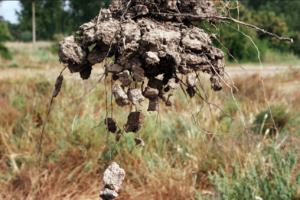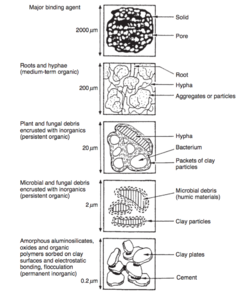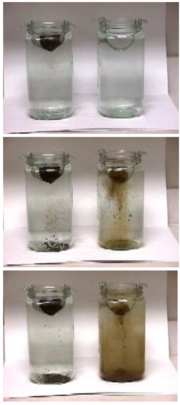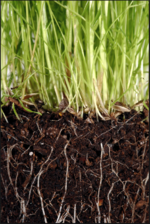Aggregate formation: Difference between revisions
m The LinkTitles extension automatically added links to existing pages (<a rel="nofollow" class="external free" href="https://github.com/bovender/LinkTitles">https://github.com/bovender/LinkTitles</a>). |
m The LinkTitles extension automatically added links to existing pages (<a rel="nofollow" class="external free" href="https://github.com/bovender/LinkTitles">https://github.com/bovender/LinkTitles</a>). |
||
| (One intermediate revision by the same user not shown) | |||
| Line 1: | Line 1: | ||
== '''Soil Aggregates''' == | == '''Soil Aggregates''' == | ||
Soil aggregates are pieces or chunks of [[soil]] that tightly bind together more so than other nearby particles. Soil particles bind in response to many factors including activity of earthworms, fungal hyphae, root exudes, and bacteria. [1] The size of soil aggregates can vary across five degrees of magnitude [1], and the size of these aggregates affect porosity, water retention, soil organic material content, erosion, and available resources for [[microorganisms]] living in the [[soil]]. [2] | Soil aggregates are pieces or chunks of [[soil]] that tightly bind together more so than other nearby particles. Soil particles bind in response to many factors including activity of earthworms, fungal hyphae, root exudes, and bacteria. [1] The size of soil aggregates can vary across five degrees of magnitude [1], and the size of these aggregates affect [[porosity]], water retention, soil organic material content, erosion, and available resources for [[microorganisms]] living in the [[soil]]. [2] | ||
[[File:aggregates.png|300px|thumb|left|Figure 1 [9] - soil aggregates attached to plant roots.]] | [[File:aggregates.png|300px|thumb|left|Figure 1 [9] - soil aggregates attached to plant roots.]] | ||
| Line 23: | Line 23: | ||
Dry environments that have extended lengths of time in between precipitation tend to yield finer soil aggregates. [7] These soils are usually not as consistently productive as those found in locations with regular rainfall. | Dry environments that have extended lengths of time in between precipitation tend to yield finer soil aggregates. [7] These soils are usually not as consistently productive as those found in locations with regular rainfall. | ||
While the surface area of microaggregates is extensive, they are also more unstable than macroaggregates, and both are needed to maintain a healthy and productive [[soil]]. Microaggregates in topsoil are prone to runoff in heavy rainfall, while macroaggregates maintain soil stability. [6] Stable soils make for good agricultural yields because they do not crumble and erode during and after rainfall, but instead retain water that will contribute to root uptake. [4] The United States Department of Agriculture (USDA) measure soil stability by suspending aggregates in water for a certain length of time and then observe the aggregates to see if they maintain their structure or crumble after being submerged. (as shown in Figure 4.) [10] If they maintain their shape, it indicates a high level of soil organic matter, nutrient content that will lead to a higher subsequent level of stability for agriculture. [4] Less stable (crumbly) soils are prone to erosion from wind and rainfall and do not usually maintain high levels of plant diversity. | While the surface area of microaggregates is extensive, they are also more unstable than macroaggregates, and both are needed to maintain a healthy and productive [[soil]]. Microaggregates in topsoil are prone to runoff in heavy rainfall, while macroaggregates maintain soil stability. [6] Stable soils make for good agricultural yields because they do not crumble and erode during and after rainfall, but instead retain water that will contribute to root uptake. [4] The United States Department of [[Agriculture]] (USDA) measure soil stability by suspending aggregates in water for a certain length of time and then observe the aggregates to see if they maintain their structure or crumble after being submerged. (as shown in Figure 4.) [10] If they maintain their shape, it indicates a high level of soil organic matter, nutrient content that will lead to a higher subsequent level of stability for agriculture. [4] Less stable (crumbly) soils are prone to erosion from wind and rainfall and do not usually maintain high levels of plant diversity. | ||
==References== | ==References== | ||
| Line 55: | Line 55: | ||
https://www.nrcs.usda.gov/wps/portal/nrcs/detail/soils/edu/?cid=nrcs142p2_054302 | https://www.nrcs.usda.gov/wps/portal/nrcs/detail/soils/edu/?cid=nrcs142p2_054302 | ||
[11] “Dave Leonard Tree Specialists.” Lexington Tree Service by Dave Leonard Tree Specialists - Emerald Ash Borer Treatment Experts, www.dlarborist.com/lawn-care.php. | [11] “Dave Leonard Tree Specialists.” Lexington Tree Service by Dave Leonard Tree Specialists - [[Emerald Ash Borer]] Treatment Experts, www.dlarborist.com/lawn-care.php. | ||
Latest revision as of 13:03, 10 May 2023
Soil Aggregates
Soil aggregates are pieces or chunks of soil that tightly bind together more so than other nearby particles. Soil particles bind in response to many factors including activity of earthworms, fungal hyphae, root exudes, and bacteria. [1] The size of soil aggregates can vary across five degrees of magnitude [1], and the size of these aggregates affect porosity, water retention, soil organic material content, erosion, and available resources for microorganisms living in the soil. [2]


Microaggregates
Microaggregates (< 250 um) are predominantly made from silt and clay and are held together by chemical charges (in the case of clay [3]) bacterial byproducts, and root exudes. [4] Earthworms have a large part in producing microaggregates through their digestion of soil organic matter (SOM), microorganisms and fungi. They also unknowingly prepare the macroaggregates via mucus from their gut which binds together microaggregates int he earthworms drilosphere. [8] Soil organic matter, climate, decomposition, and management practices are responsible for forming macroaggregates. [5]
Macroaggregates
When plant roots penetrate the soil, they anchor chunks of soil together and help form macroaggregates. Macroaggregates, which are greater than 250 micro meters are typically formed in soils with high volumes of (SOM). The breakdown of different types of detritus leads to a high diversity in the stages of SOM decomposition, which impacts the way aggregates form.

Waxy organic matter (OM) like pine needles, or material that is high in lignin, a complex organic polymer, have a slower decomposition rate. In general, waxy (OM) or lignin take more time to form stable macroaggregates in comparison to litter that contains simpler compounds. The higher decomposition rates and more (SOM) undergoing the process, the larger and more stable the aggregates become. [4] Stable macroaggregates provides a more fertile soil that is less susceptible to erosional processes. [6]

Soil Moisture and Aggregate Stability
Dry environments that have extended lengths of time in between precipitation tend to yield finer soil aggregates. [7] These soils are usually not as consistently productive as those found in locations with regular rainfall. While the surface area of microaggregates is extensive, they are also more unstable than macroaggregates, and both are needed to maintain a healthy and productive soil. Microaggregates in topsoil are prone to runoff in heavy rainfall, while macroaggregates maintain soil stability. [6] Stable soils make for good agricultural yields because they do not crumble and erode during and after rainfall, but instead retain water that will contribute to root uptake. [4] The United States Department of Agriculture (USDA) measure soil stability by suspending aggregates in water for a certain length of time and then observe the aggregates to see if they maintain their structure or crumble after being submerged. (as shown in Figure 4.) [10] If they maintain their shape, it indicates a high level of soil organic matter, nutrient content that will lead to a higher subsequent level of stability for agriculture. [4] Less stable (crumbly) soils are prone to erosion from wind and rainfall and do not usually maintain high levels of plant diversity.
References
[1] Coleman, David C., et al. Fundamentals of Soil Ecology. Elsevier Academic Press, 2004.
[2] Spohn, Marie, and Luise Giani. “Impacts of Land Use Change on Soil Aggregation and Aggregate Stabilizing Compounds as Dependent on Time.” Soil Biology and Biochemistry, vol. 43, no. 5, 2011, pp. 1081–1088., doi:10.1016/j.soilbio.2011.01.029. https://www.researchgate.net/publication/251496502_Impacts_of_land_use_change_on_soil_aggregation_and_aggregate_stabilizing_compounds_as_dependent_on_time
[3] Regelink, Inge C., et al. “Linkages between Aggregate Formation, Porosity and Soil Chemical Properties.” Geoderma, vol. 247-248, 2015, pp. 24–37., doi:10.1016/j.geoderma.2015.01.022. https://www.academia.edu/15069415/Linkages_between_aggregate_formation_porosity_and_soil_chemical_properties
[4] United States Department of Agriculture, and National Resource Conservation Service. “Soil Quality Indicators: Aggregate Stability.” Apr. 1996. https://www.nrcs.usda.gov/Internet/FSE_DOCUMENTS/nrcs142p2_052820.pdf
[5] Jastrow, J.d. “Soil Aggregate Formation and the Accrual of Particulate and Mineral-Associated Organic Matter.” Soil Biology and Biochemistry, vol. 28, no. 4-5, 1996, pp. 665–676., doi:10.1016/0038-0717(95)00159-x. https://www.sciencedirect.com/science/article/abs/pii/003807179500159X
[6] Bensard, E., et al. “Fate of Particulate Organic Matter in Soil Aggregates during Cultivation.” European Journal of Soil Science, Wiley/Blackwell (10.1111), 10 Aug. 2005, onlinelibrary.wiley.com/doi/10.1111/j.1365-2389.1996.tb01849.x/abstract. https://onlinelibrary.wiley.com/doi/abs/10.1111/j.1365-2389.1996.tb01849.x
[7] Semmel, H., et al. “The Dynamics of Soil Aggregate Formation and the Effect on Soil Physical Properties.” Soil Technology, vol. 3, no. 2, 1990, pp. 113–129., doi:10.1016/s0933-3630(05)80002-9. https://www.sciencedirect.com/science/article/abs/pii/S0933363005800029
[8] Six, Johan, and Keith Paustian. “Aggregate-Associated Soil Organic Matter as an Ecosystem Property and a Measurement Tool.” Soil Biology and Biochemistry, vol. 68, 2014, doi:10.1016/j.soilbio.2013.06.014. https://jmie.pure.elsevier.com/en/publications/aggregate-associated-soil-organic-matter-as-an-ecosystem-property
[9] Jordan, Antonio. “Soil Aggregation - What Is Soil Structure?” Soil System Sciences, The European Geosciences Union, 19 Aug. 2013, blogs.egu.eu/divisions/sss/tag/soil-aggregation/. https://blogs.egu.eu/divisions/sss/tag/soil-aggregation/
[10]“Soil Organic Matter (Aggregate Stability).” USDA / NRCS, Natural Resources Conservation Service, www.nrcs.usda.gov/wps/portal/nrcs/detail/soils/edu/?cid=nrcs142p2_054302. https://www.nrcs.usda.gov/wps/portal/nrcs/detail/soils/edu/?cid=nrcs142p2_054302
[11] “Dave Leonard Tree Specialists.” Lexington Tree Service by Dave Leonard Tree Specialists - Emerald Ash Borer Treatment Experts, www.dlarborist.com/lawn-care.php.